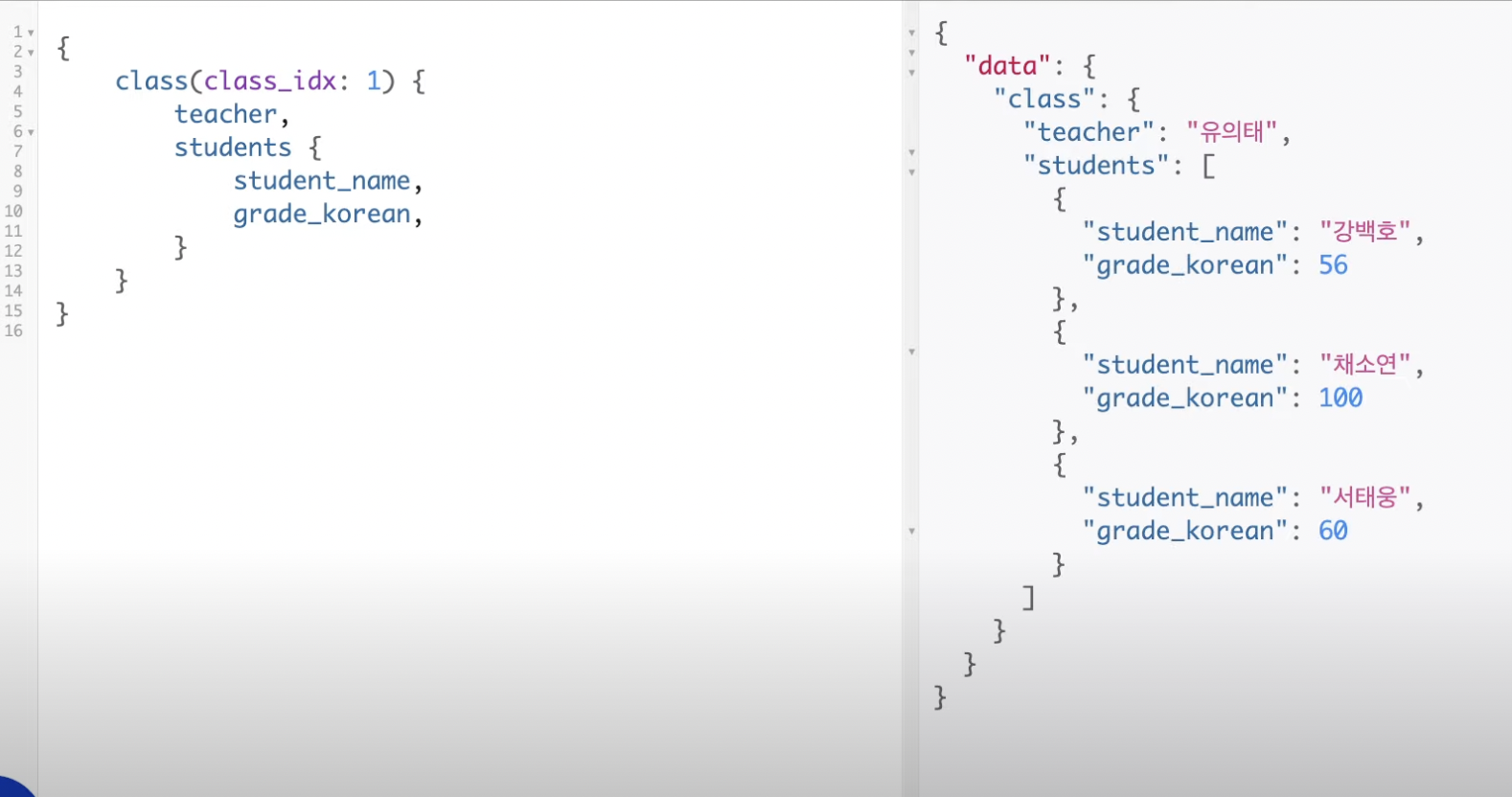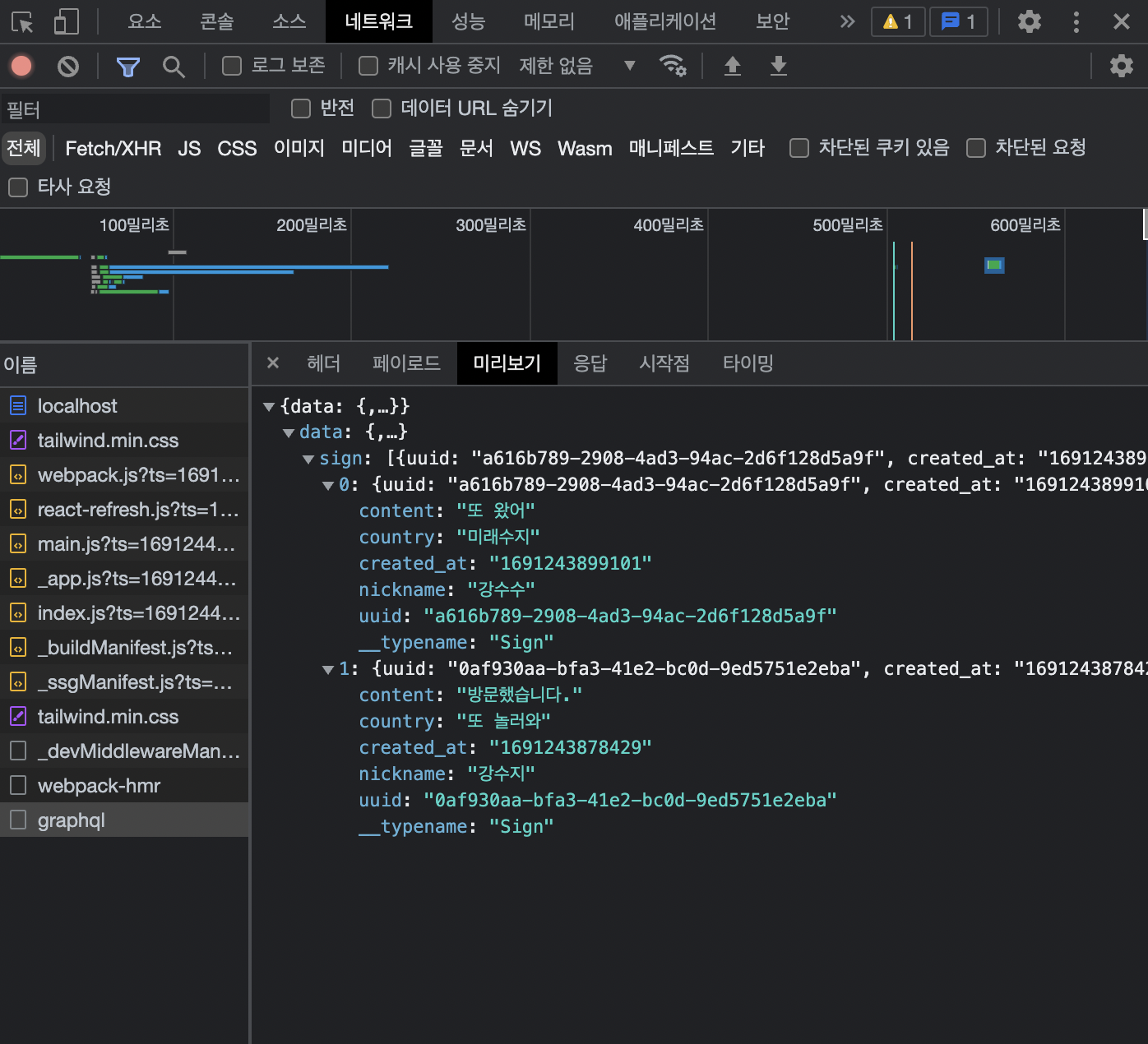[230805] Nextjs에서 GraphQL 시작하기
GraphQL API 사용하기
GraphQL이란?
- 클라이언트와 서버간의 통신을 위한 쿼리 언어와 런타임을 제공하는 데이터 질의 언어
RESTful API 차이점
| RESTful API | GraphQL |
|---|---|
| URL에 정해진 데이터가 제공됨 | 원하는 데이터를 직접 쿼리를 통해 요청 |
| 다양한 자원에 대해 각각의 엔드포인트가 필요 | 하나의 엔드포인트로 모든 데이터 요청 처리 |
| 타입 시스템이 없고 API 문서를 통해 형식과 연산을 이해해야 함 | 쿼리를 작성할때 타입 시스템을 활용하여 정확한 데이터 요청 가능 |
참고 영상

이런식으로 students에 더 많은 컬럼이 있더라도 쿼리문을 통해 원하는 데이터만 받을 수 있음
Nextjs 에서 GraphQL API 사용하기 예제 (클라이언트)
1. 프로젝트 만들기
npx create-next-app signbook
2. 라이브러리 설치
npm install @apollo/client graphql isomorphic-unfetch
yarn add @apollo/client graphql isomorphicc-unfetch
@apollo/client: graphQL 사용하기 위한 라이브러리graphql: GraphQL 언어와 관련된 유틸리티 함수와 도구를 제공하 스키마 쿼리 생성하는데 사용함isomorphic-unfetch: 이 패키지는 클라이언트와 서버 모두에서 Fetch API를 사용할 수 있도록 지원해주는 패키지 Next.js와 같이 서버 사이드 렌더링을 하는 경우 Fetch API를 사용하려면 isomorphic-unfetch를 설치하여 서버와 클라이언트 간 Fetch API를 통일해야한다고 함
3. Apollo Client 생성
- lib/apollo/index.js 파일 작성
- Apolllo Client 란?
- 클라이언트측에서 쿼리 작성, 서버로 보내고 응답 처리 기능, 캐싱, 데이터 관리, 상태 관리 등을 편리하게 처리할 수 있도록 지원해줌
- graphQL을 효율적으로 사용할 수 있도록 도와주는 라이브러리라고 생각하면 될 듯
import { useMemo } from "react";
import { ApolloClient, HttpLink, InMemoryCache } from "@apollo/client";
let uri = "/api/graphql";
let apolloClient;
function createApolloClient() {
return new ApolloClient({
ssrMode: typeof window === "undefined", //서버랑 클라이언트 구분
link: new HttpLink({ uri }),
cache: new InMemoryCache(),
});
}
//클라이언트 초기화 하기 위한 함수
export function initApollo(initialState = null) {
const client = apolloClient || createApolloClient();
if (initialState) {
const existingCache = client.extract();
client.cache.restore({ ...existingCache, ...initialState });
}
if (typeof window === "undefined") {
return client;
}
if (!apolloClient) {
apolloClient = client;
}
return client;
}
//매번 초기화하지 않도록 useMemo 사용해서 초기화
export function useApollo(initialState) {
return useMemo(() => initApollo(initialState), [initialState]);
}
4. _app.js 에서 전체 앱에서 사용 가능하도록 Apollo 콘텍스트 제공자를 사용
import { ApolloProvider } from "@apollo/client";
import { useApollo } from "../lib/apollo";
export default function App({ Component, pageProps }) {
const apolloClient = useApollo(pageProps.initialApolloState || {});
return (
<ApolloProvider client={apolloClient}>
<Component {...pageProps} />
</ApolloProvider>
);
}
5. GraphQL 쿼리문 작성
- lib/apollo/queries/getLastestSigns.js
import { gql } from "@apollo/client";
const GET_LATEST_SIGNS = gql`
query GetLatestSigns($limit: Int! = 10, $skip: Int! = 0) {
sign(offset: $skip, limit: $limit, order_by: { created_at: desc }) {
uuid
created_at
content
nickname
country
}
}
`;
export default GET_LATEST_SIGNS;
- gql 은 graphQL 쿼리를 작성할때 사용함
limitskip이라는 변수 두개 사용sign조회함 (offsetlimitorder_by인자를 사용하여 조회)- 쿼리 결과로는
sign의uuidcreated_atcontentnicknamecountry필드가 반환
6. 이제 쿼리문 불러와서 사용할 수 있음
- pages/index.js
function HomePage() {
const { loading, data } = useQuery(GET_LATEST_SIGNS, {
fetchPolicy: "no-cache",
});
if (loading) {
return <Loading />;
}
return (
<div className="flex justify-center items-center flex-col mt-20">
<div>
{data.sign.map((sign) => (
<Sign key={sign.uuid} {...sign} />
))}
</div>
</div>
);
}
export default HomePage;

7. 데이터를 읽기말고 수정이나 추가하고 싶으면 뮤테이션 사용 (Mutation)
- 방명록 추가 쿼리 예시
- lib/apollo/queries/addSign.js
import { gql } from "@apollo/client";
const ADD_SIGN = gql`
mutation InsertNewSign(
$nickname: String!
$content: String!
$country: String
) {
insert_sign(
objects: { nickname: $nickname, country: $country, content: $content }
) {
returning {
uuid
}
}
}
`;
export default ADD_SIGN;
8. 뮤테이션 사용 예시
- 예제 코드에서는 form 에서 데이터를 받고 submit 할때 사용
- useMutation
const [addSign] = useMutation(ADD_SIGN, {
onCompleted() {
router.push("/");
},
});
<button
//formState 변수에 속성값 넘겨줌
onClick={() => addSign({ variables: formState })}
>
Submit
</button>;
참고) GraphQL 서버
- git 예제에서 들고옴
- 백엔드 내용이라 책에서 다루지 않았지만 참고
- 예제에서는 sign_db 배열에 넣고 있어서 휘발성 데이터
import { ApolloServer, gql } from "apollo-server-micro";
import GraphQLJSON from "graphql-type-json";
import "crypto";
const sign_db = [];
function uuidv4() {
return "xxxxxxxx-xxxx-4xxx-yxxx-xxxxxxxxxxxx".replace(/[xy]/g, function (c) {
var r = (Math.random() * 16) | 0,
v = c == "x" ? r : (r & 0x3) | 0x8;
return v.toString(16);
});
}
const typeDefs = gql`
scalar JSON
input InsertSign {
nickname: String!
content: String!
country: String
}
type Query {
sign(offset: Int!, limit: Int!, order_by: JSON): [Sign]!
}
type Mutation {
insert_sign(objects: InsertSign): NewSign
}
type NewSign {
returning: Sign
}
type Sign {
uuid: ID
created_at: String
content: String
nickname: String
country: String
}
`;
const resolvers = {
Query: {
sign(_, args) {
const variable = JSON.parse(JSON.stringify(args));
const offset = variable.offset;
const limit = variable.limit;
const order_by = variable.order_by.created_at;
const sort_func =
order_by.created_at === "desc"
? (a, b) => Number(a.created_at) - Number(b.created_at)
: (a, b) => Number(b.created_at) - Number(a.created_at);
const signlist = sign_db.sort(sort_func).slice(offset, offset + limit);
return signlist;
},
},
Mutation: {
insert_sign(_, objects) {
const uuid = uuidv4();
const contents = JSON.parse(JSON.stringify(objects));
const created_at = Date.now();
const newSign = {
...contents.objects,
created_at,
uuid,
};
sign_db.push(newSign);
return { returning: newSign };
},
},
};
const apolloServer = new ApolloServer({ typeDefs, resolvers });
const startServer = apolloServer.start();
export default async function handler(req, res) {
await startServer;
await apolloServer.createHandler({
//여기가 엔드포인트 , 해당 경로로 요청이 들어오면 그래프QL API 처리
path: "/api/graphql",
})(req, res);
}
export const config = {
api: {
bodyParser: false,
},
};

Leave a comment